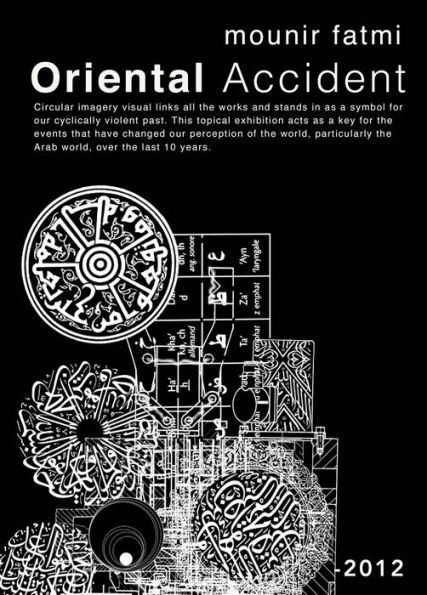"Oriental Accident, the piece for which the show is named and the center point for the exhibition, speaks to violent tension between tradition and youth in the contemporary Arab world. Recordings gathered from the demonstration in Maghreb during the Arab Spring play from speakers embedded into ornate Persian rug. Fatmi references the momentous rebellion again in The Year Zero, bas-relief that forms the number zero within an arrangement of coaxial antenna cables and cable pins. The empty space within the cable work is what gives the pieces its weight, just as the word zero gave numeric meaning to nothingness. Fatmi is referring to the infinite nothingness of a new beginning. Within the severe presence of Fatmi’s politics, the works are sprinkled with references to art history, film and literature. This conceptual dichotomy is also apparent in the visuals of the exhibition. Delicate lace is vandalized with black paint in Oil Oil Oil Oil and the white on white bas-reliefs are both muted and energetic. Traditional Arabic calligraphy is recontextualized in the videos works Mixology and Modern times, a History of the Machine, the calligraphy morphs to become graceful patterns, contrasting with the backdrop against which the artist is showing them."
"Oriental Accident, the piece for which the show is named and the center point for the exhibition, speaks to violent tension between tradition and youth in the contemporary Arab world. Recordings gathered from the demonstration in Maghreb during the Arab Spring play from speakers embedded into ornate Persian rug. Fatmi references the momentous rebellion again in The Year Zero, bas-relief that forms the number zero within an arrangement of coaxial antenna cables and cable pins. The empty space within the cable work is what gives the pieces its weight, just as the word zero gave numeric meaning to nothingness. Fatmi is referring to the infinite nothingness of a new beginning. Within the severe presence of Fatmi’s politics, the works are sprinkled with references to art history, film and literature. This conceptual dichotomy is also apparent in the visuals of the exhibition. Delicate lace is vandalized with black paint in Oil Oil Oil Oil and the white on white bas-reliefs are both muted and energetic. Traditional Arabic calligraphy is recontextualized in the videos works Mixology and Modern times, a History of the Machine, the calligraphy morphs to become graceful patterns, contrasting with the backdrop against which the artist is showing them."

Oriental Accident

Oriental Accident

Product Details
| BN ID: | 2940165075520 |
|---|---|
| Publisher: | Mounir Fatmi |
| Publication date: | 11/02/2021 |
| Sold by: | Smashwords |
| Format: | eBook |
| File size: | 7 MB |
| Age Range: | 18 Years |
